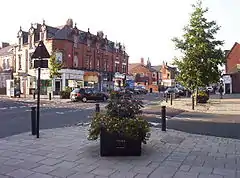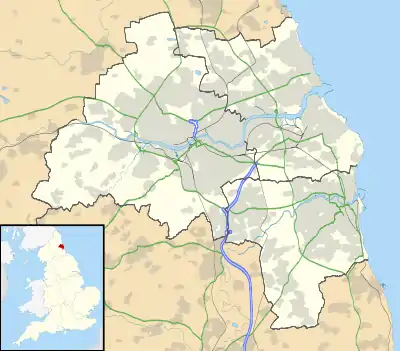Heaton, Newcastle upon Tyne
Heaton is a suburb in the east end of Newcastle upon Tyne, England, about 2 miles (3 km) from the city centre. It is bordered by the neighbouring areas of High Heaton and Cochrane Park to the north, Walker and Walkergate to the east, Byker to the south and Jesmond and Sandyford to the west. The name Heaton means high town, referring to the area "being situated on hills above the Ouseburn, a tributary of the River Tyne."
| Heaton | |
|---|---|
 Chillingham Road, Heaton's main commercial street | |
 Heaton Location within Tyne and Wear | |
| OS grid reference | NZ273660 |
| • London | 242 miles (389 km) |
| Metropolitan borough | |
| Metropolitan county | |
| Region | |
| Country | England |
| Sovereign state | United Kingdom |
| Post town | NEWCASTLE UPON TYNE |
| Postcode district | NE6 |
| Dialling code | 0191 |
| Police | Northumbria |
| Fire | Tyne and Wear |
| Ambulance | North East |
| UK Parliament | |
| Councillors | |
History
In the 12th century Heaton became part of the Barony of Ellingham granted by Henry I to Nicholas de Grenville. King John stayed in the castle at Heaton (the remains of which can still be seen in Heaton Park) on a number of occasions. In the 17th century the Heaton estate was purchased by Henry Babington who was knighted at Heaton Hall by James I on 1 May 1617.[1]
By the 18th century, Heaton was a coal mining area[2] with many of its collieries owned by Matthew White and Richard Ridley. The Heaton estate was broken up in 1835 when the area became officially incorporated into Newcastle upon Tyne. Much of the land in Heaton in 1841 was owned by Armorer Donkin, who on his death in 1851 bequeathed the land to his business partner, the industrialist Sir William Armstrong.[3]
In 1879, the corporation acquired part of the Heaton Hall estate, which was then laid out as Heaton Park, and Sir William Armstrong donated Armstrong Park and Jesmond Dene to the city.[4] The three parks run into each other to form a green corridor through east Newcastle.
Governance
Heaton was divided into two electoral wards, North Heaton and South Heaton, each of which was represented by three councillors. However, boundary changes to all wards in Newcastle upon Tyne were implemented at the city council elections in May 2018, with the majority of Heaton falling in the Heaton ward. A small part of Heaton close to Shields Road is in the Ouseburn ward, with neighbouring High Heaton included in the Manor Park ward. [5]
Demography

.jpg.webp)
Heaton is a mixed working class and middle class area. In recent years it has become a popular residence for many students attending the city's two universities, Newcastle University and Northumbria University. Rent and student letting is generally lower in price than in the neighbouring student areas of Jesmond and Sandyford.
Economy
During the 19th century, the building of the railways saw a line pass through Heaton, now the East Coast Main Line. Heaton also has a major rail depot. Heaton became the location of Sir Charles Parsons engineering works producing turbines which was founded in 1889.[6]
Third Avenue was the birthplace of the Ringtons Tea business.[7]
The main commercial street in Heaton is Chillingham Road which benefits from local amenities including two small supermarkets, a number of small shops and newsagents, hairdressers, takeaways, cafes, restaurants and public houses, aswell as some local businesses on the side streets of Chillingham Road, such as Vincenzo's Heaton [8]
In the Cochrane Park area of Heaton there is a famous landmark building, The Wills Building, which was built in 1946-50 as a cigarette factory[9] and was redeveloped in 1999 as luxury apartments.
Transport
Heaton was originally served by Heaton railway station, which was on the main line from Newcastle to Edinburgh Waverley and also on the direct line from Newcastle to the coast. That station was closed on 11 August 1980, when the Tyne & Wear Metro system opened.[10] Heaton is now served by Chillingham Road Metro station, but Byker Metro station is closer for some living in South Heaton. Heaton is also served by a variety of bus routes, including routes 1, 62 and 63, which link Heaton to Newcastle city centre and areas in the west of Newcastle.
Education
Heaton has a large secondary school, Heaton Manor School, although many children in Heaton attend Benfield School, located on the Heaton/Walkergate boundary. There are also a number of primary schools spread over the area: Ravenswood Primary School, Chillingham Road Primary School, Hotspur Primary School and St. Theresa's Primary School.[11]
Sport
Heaton was home to Newcastle United under their previous name, Newcastle East End F.C., between 1886 and 1892. East End played at the Heaton Junction Ground on Chillingham Road before moving to St James' Park.[12]
Two Northern League football clubs play in areas neighboring Heaton. Heaton Stannington F.C. play in High Heaton, while Newcastle Benfield F.C. play next door to Benfield School.
Heaton is also home to amateur rugby football club Medicals RFC, based in Cartington Terrace.
Notable people
- Ove Arup (1895-1988), structural engineer.[13]
- Jack Common (1903–68), author of 'Kiddar's Luck' and 'The Ampersand', was born and brought up at 44 Third Avenue, Heaton[14] and attended Chillingham Road Primary School; his novels give a vivid portrait of the area in the early 20th century. Common was later to model for the bust of Karl Marx that tops Marx's tomb in Highgate Cemetery, London.
- Chas Chandler (1938–96), bassist for the Animals. Manager of the Jimi Hendrix Experience and Slade. It is reputed that Jimi Hendrix himself busked on Chillingham Road during his time living with Chas in Heaton[15] at 35 Second Avenue.
- Cheryl Cole was born in Heaton on 30 June 1983 and lived there until the mid-1990s when she moved to nearby Walker.[16]
References
- John Nichols, Progresses of James the First, vol. 3 (London, 1828), p. 281.
- http://www.chroniclelive.co.uk/lifestyle/nostalgia/remember-when-heaton-road-newcastle-7935707
- Morgan, Alan (2012). Heaton from farms to foundries. Tyne Bridge Publishing. p. 9. ISBN 978-1-857952-06-3.
- http://www.chroniclelive.co.uk/lifestyle/nostalgia/remember-when-heaton-road-newcastle-7935707
- "Electoral Review of Newcastle". Newcastle City Council. Retrieved 5 May 2018.
- http://www.chroniclelive.co.uk/lifestyle/nostalgia/tyneside-factory-ca-parsons-powered-1946718
- https://www.thenorthernecho.co.uk/news/7069879.going-potty-tea-company-exhibition/
- Walton Robinson. "What's it like to live in Heaton?". Retrieved 31 August 2012.
- Pearson, Lynn F. (1996). Northern City - An Architectural History of Newcastle upon Tyne. Newcastle City Libraries. p. 50. ISBN 1-85795-087-9.
- http://www.disused-stations.org.uk/h/heaton/
- https://www.chroniclelive.co.uk/news/north-east-news/heaton-newcastle-suburb-guide-12445990
- http://www.chroniclelive.co.uk/lifestyle/nostalgia/remember-when-heaton-road-newcastle-7935707
- https://heatonhistorygroup.org/2018/02/20/sir-ove-arup-engineer-and-philosopher/
- https://heatonhistorygroup.org/2013/09/29/jack-common/
- http://www.chroniclelive.co.uk/news/history/how-jimi-hendrix-rocked-newcastle-10079033
- Chronicle, Evening (1 January 2012). "Ten interesting facts about Heaton". ChronicleLive. Retrieved 7 October 2020.